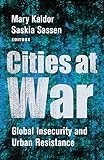Cities at War : Global Insecurity and Urban Resistance / ed. by Mary Kaldor, Saskia Sassen.
Material type: TextPublisher: New York, NY : Columbia University Press, [2020]Copyright date: ©2020Description: 1 online resourceContent type:
TextPublisher: New York, NY : Columbia University Press, [2020]Copyright date: ©2020Description: 1 online resourceContent type: - 9780231185387
- 9780231546133
- Human security -- Developing countries -- Case studies
- Internal security -- Developing countries -- Case studies
- Low-intensity conflicts (Military science) -- Developing countries
- Metropolitan areas -- Developing countries -- Strategic aspects
- Political violence -- Developing countries -- Case studies
- Sociology, Urban
- Urban violence -- Developing countries -- Case studies
- Urban warfare -- Developing countries -- Case studies
- SOCIAL SCIENCE / Sociology / Urban
- 355.4/26 23
- U167.5.S7 K35 2020
- U167.5.S7 C58 2020
- online - DeGruyter
- Issued also in print.
| Item type | Current library | Call number | URL | Status | Notes | Barcode | |
|---|---|---|---|---|---|---|---|
 eBook
eBook
|
Biblioteca "Angelicum" Pont. Univ. S.Tommaso d'Aquino Nuvola online | online - DeGruyter (Browse shelf(Opens below)) | Online access | Not for loan (Accesso limitato) | Accesso per gli utenti autorizzati / Access for authorized users | (dgr)9780231546133 |
Frontmatter -- Contents -- Acknowledgments -- Introduction: Global Insecurity and Urban Capabilities -- 1. Bamako, Mali: Danger and the Divided Geography of International Intervention -- 2. Kabul: Bridging the Gap Between the State and the People -- 3. Baghdad: War and Insecurity in the City -- 4. A Tale of Two Cities: Ciudad Juárez, El Paso, and Insecurity at the U.S.-Mexico Border -- 5. Responding to, or Perpetuating, Urban Insecurity? Enclave-Making in Karachi -- 6. Violent Conflict and Urbanization in Eastern Democratic Republic of the Congo: The City as a Safe Haven -- 7. Navigating Security in Bogotá -- 8. "On the Margins of All Margins": Explaining (In)Security in Novi Pazar, Serbia -- Conclusion: Spaces for Tactical Urbanism -- Contributors -- Index
restricted access online access with authorization star
http://purl.org/coar/access_right/c_16ec
Warfare in the twenty-first century goes well beyond conventional armies and nation-states. In a world of diffuse conflicts taking place across sprawling cities, war has become fragmented and uneven to match its settings. Yet the analysis of failed states, civil war, and state building rarely considers the city, rather than the country, as the terrain of battle.In Cities at War, Mary Kaldor and Saskia Sassen assemble an international team of scholars to examine cities as sites of contemporary warfare and insecurity. Reflecting Kaldor's expertise on security cultures and Sassen's perspective on cities and their geographies, they develop new insight into how cities and their residents encounter instability and conflict, as well as the ways in which urban forms provide possibilities for countering violence. Through a series of case studies of cities including Baghdad, Bogotá, Ciudad Juarez, Kabul, and Karachi, the book reveals the unequal distribution of insecurity as well as how urban capabilities might offer resistance and hope. Through analyses of how contemporary forms of identity, inequality, and segregation interact with the built environment, Cities at War explains why and how political violence has become increasingly urbanized. It also points toward the capacity of the city to shape a different kind of urban subjectivity that can serve as a foundation for a more peaceful and equitable future.
Issued also in print.
Mode of access: Internet via World Wide Web.
In English.
Description based on online resource; title from PDF title page (publisher's Web site, viewed 02. Mrz 2022)


